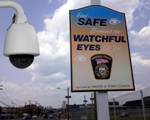Just weeks after the House Energy and Commerce Committee approved a seven-year extension of the current chemical security standards, the House Homeland Security Committee recently followed suit, approving H.R. 901 by a bipartisan vote of 26 to 5.
Henley-Putnam University, an institution specializing in strategic security and ASIS International, an organization for security professionals recently announced a strategic partnership. One of the steps in this partnership is a scholarship for ASIS members who pursue a degree in strategic security at Henley-Putnam University.

Town of Harrison Police Department in New Jersey improved their performance by deploying a city-wide wireless surveillance system based on IndigoVision’s IP video technology.
The Security Industry Association honored Congressman Frank Pallone, Jr., D-N.J., Congresswoman Candice Miller, D-MI, and John Romanowich, President/CEO and founder of SightLogix, with industry awards.
NYU Langone Medical Center announced recently that it is the first medical center in the Northeast to use PatientSecure -- a cutting-edge biometric technology -- to identify patients. Utilizing near infrared light to map an image of the blood-flow pattern through the veins in a person’s palm, the digital palm image is converted into a unique patient identifier that interfaces with the medical center’s electronic health record system.
DigitalPersona, Inc., a global provider of authentication and endpoint protection solutions, recently announced Sailormen, Inc., the largest Popeye's Chicken & Biscuits franchise in the U.S., is rolling out U.are.U Fingerprint Readers to 148 locations throughout Alabama, Illinois, Florida, Georgia, Louisiana, Mississippi and Missouri. Sailormen, Inc. has found that the deployment of fingerprint biometrics as a part of their point-of-sale (POS) systems, has improved employee accountability, increased sales, and reduced both unauthorized transactions and payroll fraud.
The Georgia Center, a conference center and hotel on the campus of the University of Georgia (UGA), is working with Merchant Link, a cloud-based payment gateway and data security solutions provider, to install the company's TransactionShield point-to-point encryption solution ensuring customer data is secure from the moment their credit card is swiped.
3VR, Inc., the video intelligence company, announced that three credit unions across the state of Washington installed 3VR's video intelligence platform to reduce fraud and solve crimes. 3VR integrator Cook Security Group led the deployments at O Bee Credit Union, Our Community Credit Union and the Washington State Employees Credit Union (WSECU).
According to a new study from ABI Research, the worldwide market for hosted virtual desktops is forecast to grow from about $500 million in 2009 to a cumulative total of nearly $5 billion in 2016. North America and Europe will comprise the majority of the market for virtual desktops throughout the forecast period.
INTERPOL Secretary General Ronald K. Noble told in civil aviation industry leaders early this month that it is up to airlines to properly screen passengers' ID documents if national government fail to do so.